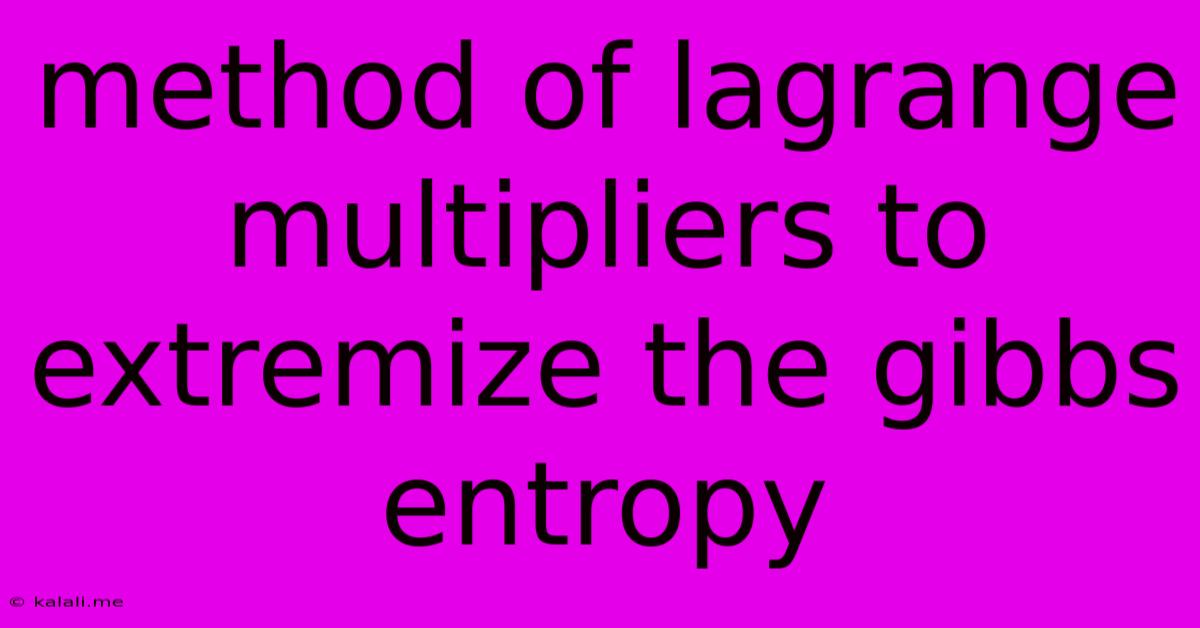Method Of Lagrange Multipliers To Extremize The Gibbs Entropy
Kalali
May 25, 2025 · 3 min read

Table of Contents
Extremizing Gibbs Entropy Using the Method of Lagrange Multipliers
This article explores the application of the method of Lagrange multipliers to find the maximum of the Gibbs entropy, a crucial concept in statistical mechanics and thermodynamics. We will delve into the mathematical formulation and provide a step-by-step explanation of the process. Understanding this method allows for a deeper understanding of the fundamental principles governing the distribution of energy within a system.
The Gibbs entropy, a measure of the disorder or randomness within a system, is defined as:
S = -k<sub>B</sub> Σ p<sub>i</sub> ln(p<sub>i</sub>)
where:
- S is the entropy
- k<sub>B</sub> is Boltzmann's constant
- p<sub>i</sub> is the probability of the system being in state i
Our goal is to maximize this entropy subject to certain constraints. Common constraints include:
- Normalization: The sum of probabilities must equal one: Σ p<sub>i</sub> = 1
- Average energy: The average energy of the system is fixed: Σ p<sub>i</sub>E<sub>i</sub> = <E>
The method of Lagrange multipliers provides an elegant way to solve this constrained optimization problem. We introduce Lagrange multipliers (λ and β) for each constraint, forming the Lagrangian:
ℒ = -k<sub>B</sub> Σ p<sub>i</sub> ln(p<sub>i</sub>) + λ (Σ p<sub>i</sub> - 1) + β (Σ p<sub>i</sub>E<sub>i</sub> - <E>)
Applying the Method of Lagrange Multipliers
To find the maximum entropy, we take the partial derivative of the Lagrangian with respect to each probability p<sub>i</sub> and set it to zero:
∂ℒ/∂p<sub>i</sub> = -k<sub>B</sub>(ln(p<sub>i</sub>) + 1) + λ + βE<sub>i</sub> = 0
Solving for p<sub>i</sub>, we get:
ln(p<sub>i</sub>) = (λ/k<sub>B</sub> -1) + (β/k<sub>B</sub>)E<sub>i</sub>
p<sub>i</sub> = exp((λ/k<sub>B</sub> -1) + (β/k<sub>B</sub>)E<sub>i</sub>)
We can simplify this expression by defining a new constant, Z:
p<sub>i</sub> = (1/Z) * exp(-βE<sub>i</sub>)
where Z = exp(1 - λ/k<sub>B</sub>) Σ exp(-βE<sub>i</sub>) is the partition function. This is the Boltzmann distribution, a cornerstone of statistical mechanics. The partition function acts as a normalization constant, ensuring that Σ p<sub>i</sub> = 1.
Interpretation of Lagrange Multipliers
The Lagrange multipliers have physical significance:
-
λ: This multiplier ensures the normalization constraint is satisfied. While not directly interpretable as a physical quantity, it’s crucial for mathematical consistency.
-
β: This multiplier is inversely proportional to the temperature (β = 1/k<sub>B</sub>T). It connects the entropy maximization to thermodynamic temperature, demonstrating a profound link between statistical mechanics and thermodynamics. A higher temperature leads to a more uniform probability distribution (higher entropy).
Conclusion
The method of Lagrange multipliers offers a powerful and elegant way to determine the probability distribution that maximizes the Gibbs entropy under constraints. This leads directly to the Boltzmann distribution, a fundamental result with far-reaching implications in various fields, highlighting the importance of this optimization technique in statistical physics and beyond. Further explorations could involve analyzing systems with additional constraints or considering different entropy formulations. The understanding of this method provides a solid foundation for advanced studies in statistical thermodynamics and related areas.
Latest Posts
Latest Posts
-
200 Amp Murray Main Breaker Replacement
Jun 01, 2025
-
Do You Add Ability Modifier To Damage Dnd
Jun 01, 2025
-
How To Drain Boiler Expansion Tank
Jun 01, 2025
-
Precedent Not Binding As To Issue Not Addressed
Jun 01, 2025
-
How To Remove Quest Badge Discord
Jun 01, 2025
Related Post
Thank you for visiting our website which covers about Method Of Lagrange Multipliers To Extremize The Gibbs Entropy . We hope the information provided has been useful to you. Feel free to contact us if you have any questions or need further assistance. See you next time and don't miss to bookmark.